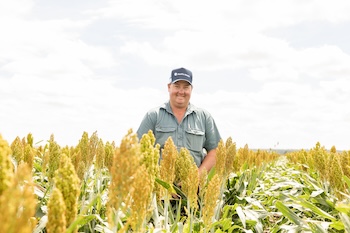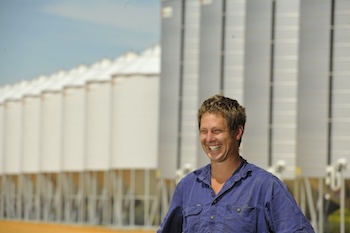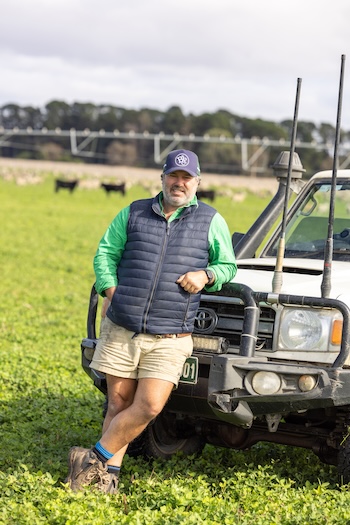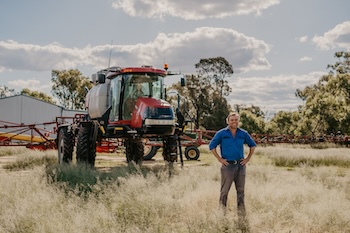Western Australia
Mitch and Emma Miolini farm with Mitch’s brother Adam and sister-in-law India, together with their parents Robert and Maxine. The Miolini family are fourth-generation farmers at Mount Walker in Western Australia, 40 kilometres east of Narembeen in the central wheatbelt. Their enterprise is a mixed farm – wheat, canola, oats, barley and lupins and 1500 breeding ewes.
The storm system Lincoln hit our farm in February. It was one of two cyclonic systems in two weeks that brought extraordinary rainfall events, dumping between 70 and 110 millimetres across the farm.
Consequently, we were busy spraying summer weeds to conserve as much of this water as we could for the season ahead. Fortunately, we had an ample supply of herbicide on hand. Sheep are also proving a useful tool in our integrated weed management plan. The winds, which are a by-product of these cyclonic events, have been a concern as the country we have ameliorated using Plozza ploughs and deep ripping is vulnerable to erosion, and we need to ensure appropriate ground cover as soon as possible. We find a TTQ roller system can help us firm the seedbeds created from ameliorating the soil.
We continue being busy ameliorating soils, Plozza-ploughing 550 hectares and deep ripping 400ha to alleviate compaction layers at depth. We tidy these ameliorated paddocks and headlands with offset discs and then need to pick rocks we may have brought to the surface. It is important to get cover on these paddocks as early as possible and – depending on rain – we usually try to achieve this in early May. Crop choices are Maximus barley, Bannister oats or Denison wheat. Cereals are good for stabilising and covering newly ameliorated country as they have vigorous fibrous root systems close to the surface and cover the ground well. For example, Denison is a slow to very slow spring maturity type suitable for early sowings.
Five hundred tonnes of lime need to be spread and then we are back into spraying for weeds, including caltrop, melons, capeweed and ryegrass. We are keeping a close watch on herbicide-resistant ryegrass as we know, through our regular monitoring, that we have around a five per cent resistant population where it occurs across the farm. An aggressive integrated weed management approach to ryegrass is necessary and we desiccate crops before the ryegrass can set seed. We also use harvest weed seed management techniques, burning windrows and, of course, our sheep! Chemical fallow or a vetch/oat/tillage radish fodder mix for sheep usually follows on these problem paddocks and this year we are thinking of trialling a RoundUp Ready canola to also assist weed management.
On the subject of weeds, we are dealing with a new species that we suspect has blown in from the eastern wheatbelt. Matricaria is a noxious and invasive weed that our sheep will not eat and is a prolific seed producer. We are working with Living Farm on a GRDC-invested National Grower Network project to investigate pre and post-emergent herbicides for its control.
Further on-farm trials are underway. Through the Corrigin Farm Improvement Group, we are working with Dr Darren Hughes from Laconik and are hosting a grower-strip-size fallow trial site as part of GRDC-supported work. Fallow plays an important role in our farming system as another form of water conservation and we are looking forward to seeing what deeper insights we can glean from this on-farm trial.
Queensland
Based at Capella, north of Emerald in Central Queensland, Tim Gersbach farms 4000ha with his wife, Courtney, their two young children and his parents, Garry and Cathy. They crop wheat, chickpeas and, occasionally, mungbeans. Sorghum is the main summer crop.
 Capella, Queensland, grower Tim Gersbach. Photo: Rowdy Travis
Capella, Queensland, grower Tim Gersbach. Photo: Rowdy Travis
We decided to spray our sorghum for both heliothis and fall armyworm (FAW) in late March. FAW was in our sorghum heads and then seemed to disappear, burrowing into the ground. They appeared again in the heads though.
We discussed the threshold for spraying with our agronomist, Josh Bell, and decided to spray. He has been checking our paddocks once or twice a week. Josh has said the story with FAW is quite complex this year. It has persisted in sorghum heads, compared to the past few years.
Based on our soil moisture profile, we are planning to plant more chickpea than usual. The chickpea market looks promising.
We had already spread with 120 kilograms/ha of urea and 25kg/ha of CK55 starter, which was done as soon as we’d planted sorghum.
We don’t usually put urea on our chickpea paddocks as they are supposed to fix nitrogen. But because we are now planting more chickpea on paddocks that were destined for wheat, we will be able to see how they perform with more urea.
Victoria
Mitch Henderson, with parents Craig and Pauline, brother Ben, cousin John and their families, grow wheat, barley, lentils and oaten hay in Berriwillock, Wilkur and Brim in Victoria’s Mallee. They also rear poultry, using their wheat straw as bedding and then spreading it back on to paddocks as manure in a closed-loop system.
With summer weed control, our profile and the current forecast, everything is pointing towards an average or above-average year. We had 25mm of rain mid-March, which gave us a bit of a weed flush, especially in the wheel tracks we had renovated after changing our boom from 43 to 48 metres. So we finished the summer weed program camera-spraying them from the boom with a Bilberry system.

We got the technology in mid-January and had done 12,000ha in 230 hours by the end of March. Because we can target specific weeds, we’re using higher chemical concentrations but reducing the total litres used. So there’s savings on chemicals and we’re getting better efficiency because we are not having to fill up as often. So we’re pretty happy.
We spread chicken manure from our broiler birds in March. It’s relatively light – about four to 5t/ha – but it provides some natural fertiliser and aids our phosphorus and trace elements. There’s a noticeable difference in the green vibrancy of the crops and more biomass but the ‘lie-detectors’ (headers) haven’t noticed a significant yield increase as yet. While it hasn’t been a game changer, I still think it’s well worth the hassle.
We started sowing in April with hay, moving into barley and lentils and we’ll aim to finish with wheat by the third week of May.
We have traditionally sown one variety each of wheat, barley and lentils to get over hectares quickly without too much fuss, but this year we are sowing two lentils (GIA Thunder and PBA Hallmark XT ) and three wheats (Scepter , Calibre and Tomahawk CL Plus ). Having Clearfieldâ tolerance, Tomahawk CL Plus will give us an insight into some different tools.
South Australia
Lachie Seears farms with wife Rebecca and children Hugh and Anneliese, along with his parents, Peter and Helen, at Lucindale in south-eastern South Australia. Their enterprise comprises cropping (wheat, canola and broad beans), 6500 breeding ewes and 1250 breeding cows and heifers (building towards 2000 breeders).
 South Australian grower Lachie Seears. Photo: Adrian Gale
South Australian grower Lachie Seears. Photo: Adrian Gale
The year started out incredibly dry in the lower south-east. Some parts of the region had heavy rain in December that disrupted harvest, but we only got 6mm back then, and we’ve had basically nothing since, apart from 20mm in January and about 10mm in the first week of April, which did nothing to get a germination because the profile was so dry.
The lack of rain has not affected our program though. Like the majority of mixed livestock and cropping operations in the lower south-east, we run a structured program and I keep coming back to the saying “stick and stay makes it pay”. There is very little dry sowing, and we tend not to chase markets based on a single year of high prices.
Having said that, we do make some minor adjustments and we plan to increase our cropping area because we see a good outlook over the next few years. This year’s program will be wheat, broad beans and canola. We are putting canola back into the program for the first time in a while, largely because we are trimming our sheep numbers by about
10 per cent and increasing the cropping area by 15 per cent. We also see this as a good time to remove some less-profitable animals.
In April, we get closer to the break of season and will be preparing our paddocks using a Speed Tiller to plough in all the stubbles. We also planned to do some strategic burning to control snails and slugs. Once we finished that, it’s a matter of sitting back and waiting for rain to get a germination of weeds, making sure all our machinery is ready to go. We have a sowing window from the start of May until mid-June to make sure we get this year’s winter crop in.
New South Wales
Andrew Freeth, with parents David and Sue and brother Marc, grows wheat, canola, chickpeas, faba beans and oats, plus 2200 ewes and trade cattle, near Collie and Trangie in central New South Wales.
We recorded 77mm of rain in February, 28mm over three days in March and more than 45mm during the first week of April.
 Central New South Wales grower Andrew Freeth. Photo: Kirsty Fisher Photography
Central New South Wales grower Andrew Freeth. Photo: Kirsty Fisher Photography
By 5 April, our Collie farm had adequate moisture for sowing. Our Trangie farm was drier. Accordingly, we didn’t plan on growing canola there. We planned to sow canola at Collie, but less than what was planted last year. The wheat area will also decrease, while the faba bean and chickpea areas will increase.
Research by Brill Ag’s Rohan Brill, with GRDC investment, prompted us to try faba beans for the first time last year with good results. Our PBA Nanu faba beans and PY520TC canola were earmarked for late April sowing. Faba beans are planted anywhere there is a risk of waterlogging. If waterlogging didn’t occur, we would probably plant our entire pulse area to chickpeas.
Plenty of time before sowing was spent on the sprayer, keeping the paddocks free of weeds. We also unloaded fertiliser and maintained our gear.
We developed a cropping plan with our agronomist, Jamie Taylor, from Nutrien in Dubbo.
By 5 April, a small amount of winter wheat Illabo had been sown for the first time for grazing and grain. The biomass production is reputed to be better than that of oats. However, Yarran oats provide valuable roughage for our ewes and a crown rot break.
We sow using a Gason Para-Maxx bar. This parallelogram system has 33.3-centimetre row spacings. It usually runs on tynes but can take discs when we need to sow into heavy stubble.
LRPB Raider , LRPB Stealth and Sunchaser wheat were planned for sowing in the first half of May. We will take a small break before finishing our program with CBA Captain chickpeas.
Our cereal varieties were selected for disease tolerance and yield, as our chickpeas generally require multiple fungicide applications to manage disease.

























































